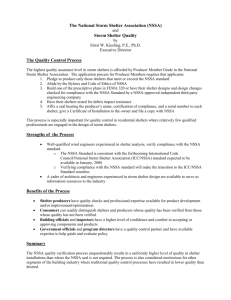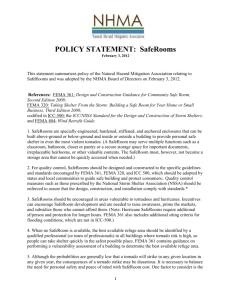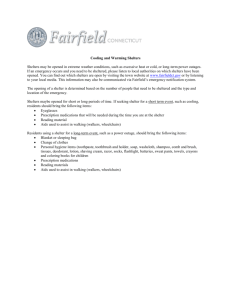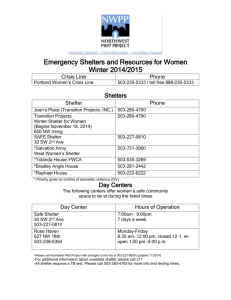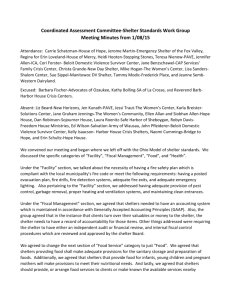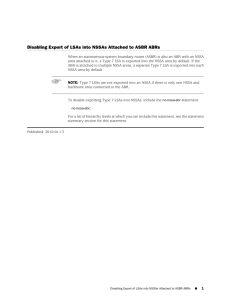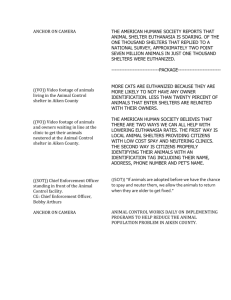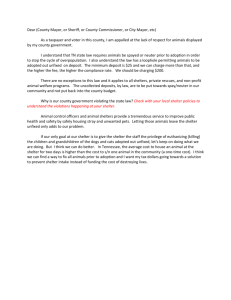Minimum Quality Assurance Level
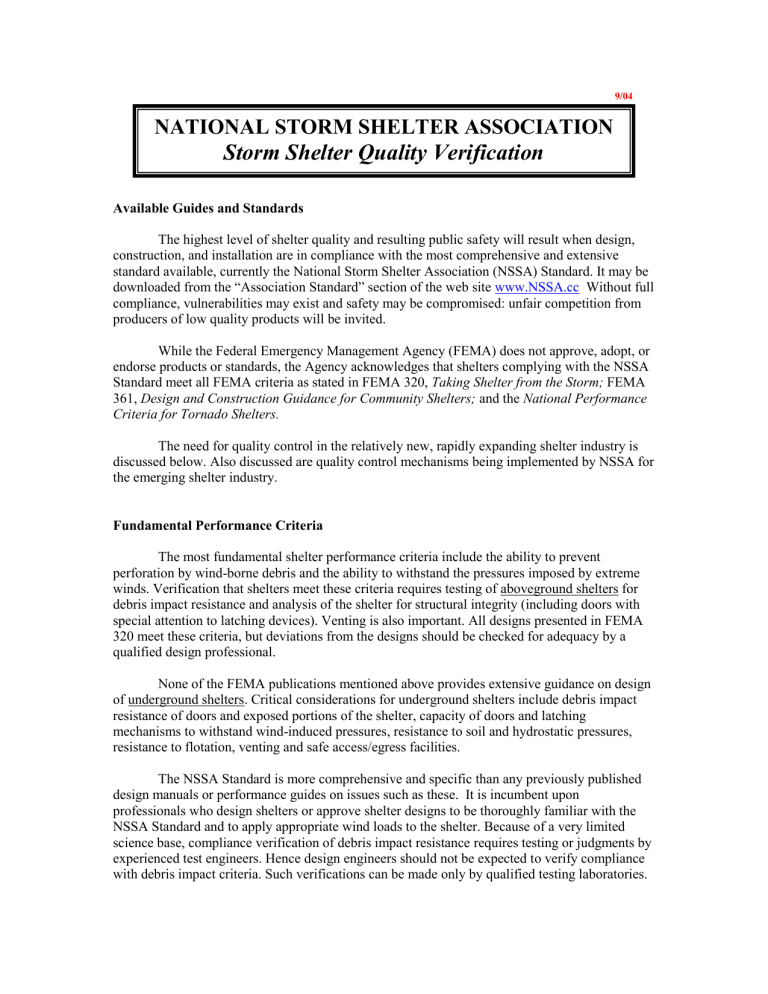
9/04
NATIONAL STORM SHELTER ASSOCIATION
Storm Shelter Quality Verification
Available Guides and Standards
The highest level of shelter quality and resulting public safety will result when design, construction, and installation are in compliance with the most comprehensive and extensive standard available, currently the National Storm Shelter Association (NSSA) Standard. It may be downloaded from the “Association Standard” section of the web site www.NSSA.cc
Without full compliance, vulnerabilities may exist and safety may be compromised: unfair competition from producers of low quality products will be invited.
While the Federal Emergency Management Agency (FEMA) does not approve, adopt, or endorse products or standards, the Agency acknowledges that shelters complying with the NSSA
Standard meet all FEMA criteria as stated in FEMA 320, Taking Shelter from the Storm; FEMA
361, Design and Construction Guidance for Community Shelters; and the National Performance
Criteria for Tornado Shelters.
The need for quality control in the relatively new, rapidly expanding shelter industry is discussed below. Also discussed are quality control mechanisms being implemented by NSSA for the emerging shelter industry.
Fundamental Performance Criteria
The most fundamental shelter performance criteria include the ability to prevent perforation by wind-borne debris and the ability to withstand the pressures imposed by extreme winds. Verification that shelters meet these criteria requires testing of aboveground shelters for debris impact resistance and analysis of the shelter for structural integrity (including doors with special attention to latching devices). Venting is also important. All designs presented in FEMA
320 meet these criteria, but deviations from the designs should be checked for adequacy by a qualified design professional.
None of the FEMA publications mentioned above provides extensive guidance on design of underground shelters. Critical considerations for underground shelters include debris impact resistance of doors and exposed portions of the shelter, capacity of doors and latching mechanisms to withstand wind-induced pressures, resistance to soil and hydrostatic pressures, resistance to flotation, venting and safe access/egress facilities.
The NSSA Standard is more comprehensive and specific than any previously published design manuals or performance guides on issues such as these. It is incumbent upon professionals who design shelters or approve shelter designs to be thoroughly familiar with the
NSSA Standard and to apply appropriate wind loads to the shelter. Because of a very limited science base, compliance verification of debris impact resistance requires testing or judgments by experienced test engineers. Hence design engineers should not be expected to verify compliance with debris impact criteria. Such verifications can be made only by qualified testing laboratories.
Highest Known Quality Assurance Level
The highest quality assurance level is afforded by MEMBER Grade in the National
Storm Shelter Association. The application process for shelter-producing MEMBERS requires that applicants:
1.
Pledge to produce only those shelters that meet or exceed the NSSA standard
2.
Abide by the Bylaws and Code of Ethics of NSSA
3.
Subject their shelter designs and design changes to the scrutiny of an independent third party
4.
Have their shelters tested for debris impact resistance
5.
File a Certificate of Installation with NSSA for each shelter installed
Shelter producer MEMBERS are required to apply a seal to each shelter produced, verifying that it was designed, constructed, and installed to meet the NSSA Standard. Each seal will bear a serial number that will be registered with NSSA. The Certificate of Installation is filed with NSSA headquarters, bearing the serial number.
This process emphasizes the professional conduct of shelter producers and their meeting or exceeding the most comprehensive performance standard available. Hence code officials or approval agencies achieve the highest level of quality assurance by recognizing shelter producers who are MEMBERS of NSSA.
Minimum Quality Assurance Level
Approval agencies for shelter installation or incentive grants can feel confident that shelters produced and installed by NSSA members meet or exceed the NSSA Standard. For shelters produced by others, approval agencies should, at a minimum, require the following of shelter producers:
Site-built residential shelters should be checked for compliance with FEMA 320 by a qualified code official, building inspector, or by a registered design professional. Deviations from
320 designs should be evaluated by a registered professional engineer whose approval is given in a document bearing a professional seal.
Producers of manufactured shelters or site-built shelters not shown in FEMA 320 should be required to present: (1) a report or letter from an NSSA-designated test laboratory (currently
Texas Tech University) indicating that the shelter meets the FEMA criteria for debris impact resistance, and (2) a letter bearing the seal of a registered professional engineer indicating that the shelter meets all aspects of the NSSA standard (exclusive of debris impact resistance requirements). Agencies approved by NSSA to make such evaluations are listed on the NSSA web site www.NSSA.cc
List of Shelter Producers
A list of shelter manufacturers who have had shelters or shelter components tested at
Texas Tech University for debris impact resistance can be viewed on the web at the Shelters
Tested section of www.wind.ttu.edu
A list of companies that have met NSSA MEMBER requirements and have received third-party verification of compliance may be found on the web at www.NSSA.cc
This list is short because few producers have invested the time and money for quality verification. The NSSA Seal program, open only to MEMBERS of NSSA, is described in the NSSA Bylaws.
